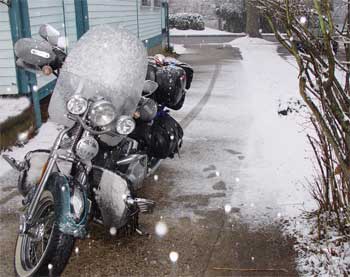Winter Riding
|
Disclaimer:
|
Upon returning from Daytona a couple years back. |
|||||||||||
|
Winter Road Hazards by: Chris Loynd S'no Way! Advice for riding in snow? Don't. At least that's the best advice I've seen. As you can see by the picture on this page, I have been caught before. But the snow was just starting and not yet enough to plow. I went slow and fortunately the big Springer tracked okay. Another time I got caught in a snow squall. That time the pavement was still plenty warm, and therefore just wet, not slick or icy. I risked it. There's actually a funny story about that ride. I was coming back from New Jersey on a Polar Bear ride and stopped in that last rest stop at the top of the Garden State Parkway. There were a few flurries here and there. No worries. But in the time it took me to grab a coffee the flurries turned into a squall. I came out to my bike in the parking lot and it was snowing like mad. What to do? I was so close to home. I drug my boots across the pavement here and there. It was just wet, not slippery at all. So I decide to go. As I'm zipping up and fastening my helmet this old guy stops and stares at me a minute. "You riding a motorcycle? In THIS?" It's okay, I reply, not really slick yet. "My God that's crusty!" the guy blurted, then hurried inside. On that snow ride the biggest problem was that my body and motorcycle windshield were colder than the pavement. So while the snow wasn't sticking to the pavement, it sure built up on my windshield and helmet visor. Visibility got to be a real challenge. I cracked the visor and kept wiping it. Over the Tappan Zee I putted along in the far right lane with my four-way flashers going. By the time I reached the Merritt Parkway the snow had stopped and the road was dry. One other snow hazard is worth mentioning: truckbergs. There are two types. Most common are the rock-hard slushbergs that build up on car and truck mud flaps, then fall off and go skittering across the road. I have never had one drop in front of me. But I have had to swerve around dirty brown chunks of ice in the road. Cars hit these things too, shooting them in all directions. The second Truckberg type generally occurs after a significant snowfall. I guess it's just too much trouble for the drivers to clear off the tops of their trailers. What happens is that you can be riding along on a perfectly dry road, days after a snowstorm, when all of the sudden a huge slab of hardened snow pops off the roof of a truck. These slam onto the road and scatter all over. Not only have I had to dodge a few of these, but also be careful because they generally leave a slippery spot where they first impact. Key to this one -- do not follow trucks in snow season. Even if we haven't seen snow in Connecticut, these guys can be coming from Maine with a fresh truckberg on their roof just waiting for you to let down your guard. Ice People talk about the dreaded black ice like it's some kind of winter monster lurking in the highway to destroy unsuspecting drivers. Geeze! I've never had much trouble with it. First of all, if the temperature is below freezing I make sure to stick to dry pavement. Secondly, ice generally is not found directly in the roadway line of travel because cars wear it off. An exception is New York City proximity roads where drainage seems to be an unlearned concept. Stay off the Cross Bronx in winter. Watch out for parkways. If there's that much ice around, you might want to stay home. My strategy is to avoid places where the black ice monster can hide. Shoulders, inside corners, shady spots are all approached with caution. Some bridges can drip from their drains and create spots of ice underneath them. And if you don't read signs there is a miniscule chance that you don't know: "Bridges freeze before road." So go easy when you're riding over bridges. Sand Usually sand lurks in the same places as ice. Once the ice melts, the sand stays. Same as ice, watch out for it, avoid it. I've never had much real trouble riding around sand. Reduced Traction Harley-Davidson's "Enthusiast" magazine (Fall 2006) suggests, "When you encounter areas of reduced traction, minimize your speed and lean angle, and balance braking pressure between front/rear." My experience is that you do not want to be making any steering or braking or accelerating inputs on ice or sand. And with a torquey Harley, that means not letting go of the throttle on ice or sand either. Just keep everything steady for a second. If you are luck and the angels are with you, and your ride bell is ringing, you will glide right over the hazard. One other traction concern, especially when starting your ride, is tire temperature. It can take up to 20 minutes of riding to warm your tires to normal operating temperature. Cold tires are slippery tires. They have to warm to get sticky. Just go easy at first. As a general rule, when the temperature is below freezing or if there has been a recent snowfall, I ride in winter like I ride in rain. Go easy! Now is not the time for scraping pegs. Accelerate and brake softly. Leave lots of extra following distance. Look far ahead. Your best defense against snow, ice and sand is avoidance. |
||||||||||||
| Back to top.
|
||||||||||||
